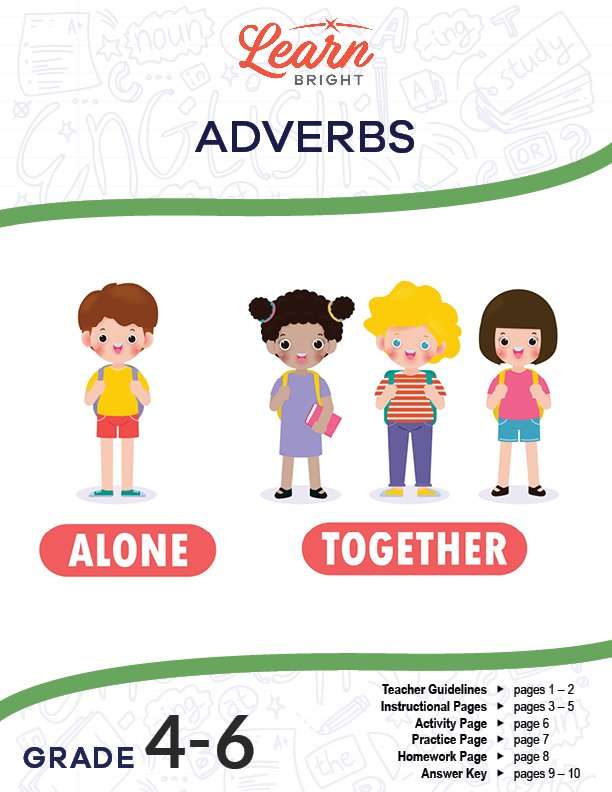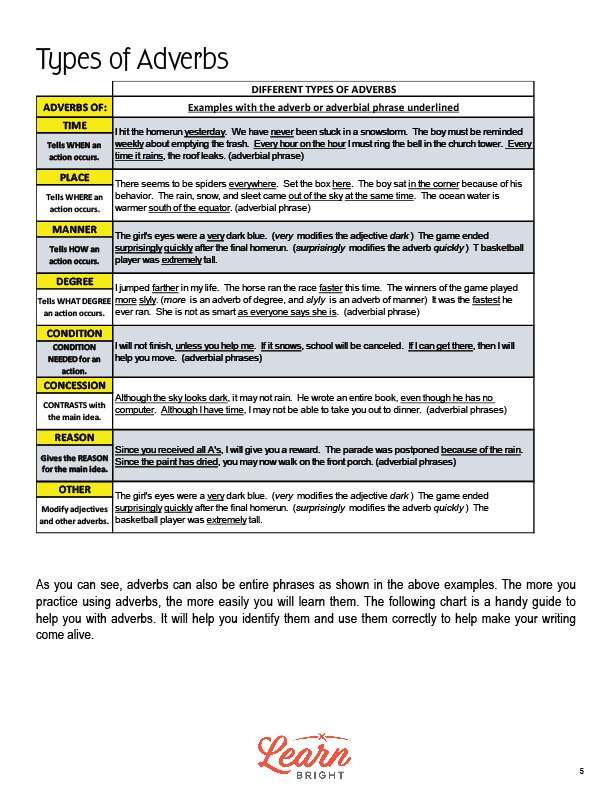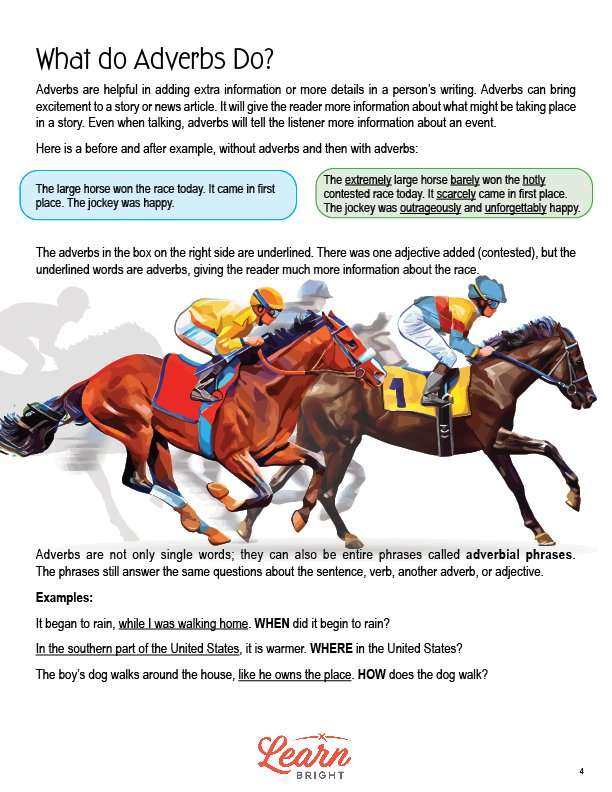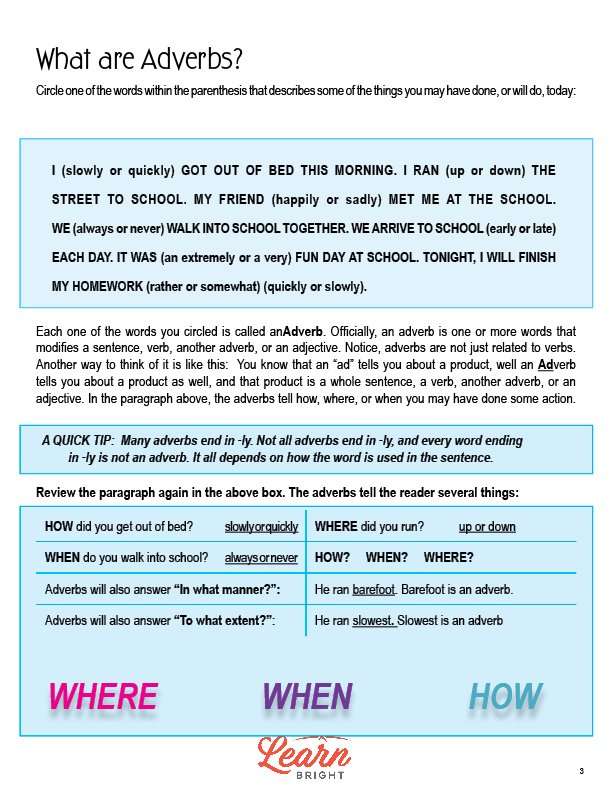Description
What our Adverbs (Grades 4-6) lesson plan includes
Lesson Objectives and Overview: Adverbs for grades 4-6 expands students’ understanding of adverbs while preparing them to define, identify, and use adverbs. This lesson both develops reading comprehension and written expression through both collaborative and individual exercises. Students are encouraged to be creative while writing original sentences using different types of adverbs, and are also asked to identify adverbs in prewritten texts. At the end of the lesson, students will be able to define an adverb, identify adverbs in sentences, and use adverbs when writing a story. This lesson is for students in 4th grade, 5th grade, and 6th grade.
Classroom Procedure
Every lesson plan provides you with a classroom procedure page that outlines a step-by-step guide to follow. You do not have to follow the guide exactly. The guide helps you organize the lesson and details when to hand out worksheets.
Teacher Notes
The teacher notes page includes a paragraph with additional guidelines and things to think about as you begin to plan your lesson. This page also includes lines that you can use to add your own notes as you’re preparing for this lesson.
ADVERBS (GRADES 4-6) LESSON PLAN CONTENT PAGES
What are Adverbs?
The Adverbs (Grades 4-6) lesson plan includes three content pages. To start the lesson, students will read a paragraph and circle one of the words within each parenthesis that describes some of the things they have done, or will do, today. They will learn that we call each of the words they circled an adverb. Adverbs are one or more words that modify a sentence, verb, another adverb, or an adjective. Adverbs relate to verbs, but also to other forms of speech. In the same way that an “ad” tells you about a product, an adverb tells you about a product (a sentence, verb, adverb, or adjective). They tell how, where, or when you might have done an action.
Many, but not all, adverbs end in -ly. It’s also important to note that not all words that end in -ly are adverbs. In the paragraph at the beginning of the lesson, the adverbs tell you several things. They tell you how you get out of bed (slowly or quickly), where you run (up or down), and when you walked into school (always or never). Adverbs also answer “in what manner?” and “to what extent?”.
What do Adverbs Do?
Adverbs help us add extra information or more details to our writing. They can bring excitement or give a reader more information about what’s taking place. You might use them when talking to tell the listener more information. The lesson includes an example of two short paragraphs, one with adverbs and one without. The paragraph with the adverbs gives the reader much more information about the event.
Adverbs can also be entire phrases, which we call adverbial phrases. They answer the same questions about the sentence, verb, another verb, or adjective.
Types of Adverbs
The lesson ends with a helpful chart of the different types of adverbs with examples of each. It includes adverbs of time, place, manner, degree, condition, concession, reason, and other.
Adverbs can be phrases, like some of the examples on this page. The more you use adverbs, the easier it will be for you to identify them.
ADVERBS (GRADES 4-6) LESSON PLAN WORKSHEETS
The Adverbs (Grades 4-6) lesson plan includes three worksheets: an activity worksheet, a practice worksheet, and a homework assignment. You can refer to the guide on the classroom procedure page to determine when to hand out each worksheet.
WHAT HAPPENS ACTIVITY WORKSHEET
The activity worksheet asks students to read through the page(s) given to them by their teacher. They will circle all of the adverbs in those pages. Next, they will exchange their pages with another student for review, reviewing the other students’ pages as well. They will underline any adverbs that the other student missed. The students will return their pages to each other and will black out all of the adverbs in the story so they can’t be seen. Next, they will reread the story and will write down what’s happened to the story. Is it better or worse? What if they had removed the adjectives instead?
To finish the activity, they will write a 10 sentence story with at least one adverb or adverb phrase in each sentence. They will circle the adverbs or adverb phrases and will then read the story again without them. Finally, they’re read their story out loud to the class, both with and without the adverbs.
UNDERLINE PRACTICE WORKSHEET
For the practice worksheet, students will complete two short exercises. For the first, they will underline each adverb in the given paragraph. And for the second, they will write in an adverb or adverb phrase in each of the blank spaces in the paragraph.
ADVERBS (GRADES 4-6) HOMEWORK ASSIGNMENT
The homework assignment asks students to write a creative sentence using each of the given types of adverbs.
Worksheet Answer Keys
This lesson plan includes answer keys for the practice worksheet and the homework assignment. If you choose to administer the lesson pages to your students via PDF, you will need to save a new file that omits these pages. Otherwise, you can simply print out the applicable pages and keep these as reference for yourself when grading assignments.










